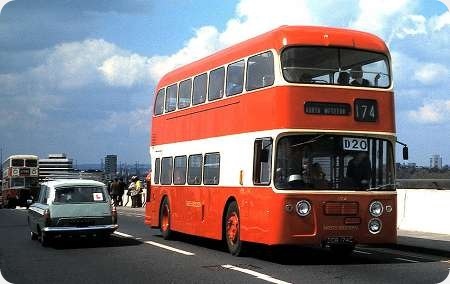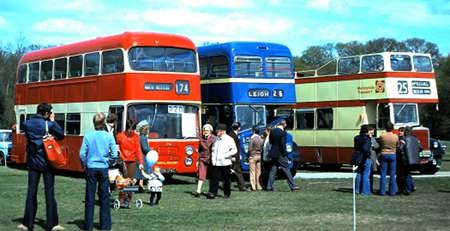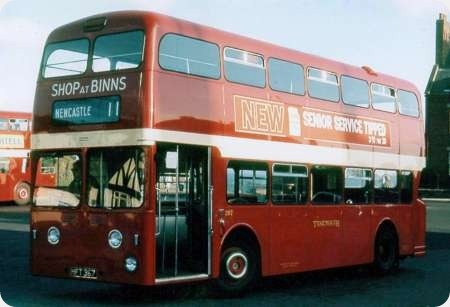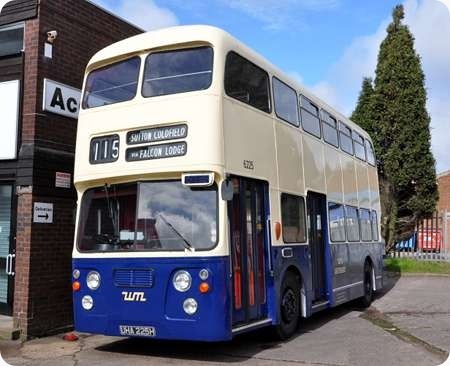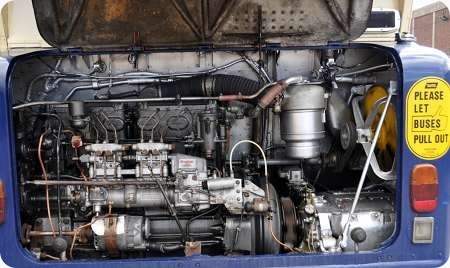North Western – Daimler Fleetline – DDB 174C – 174
North Western Road Car Co
1965
Daimler Fleetline CRG6LX
Alexander H44/31F
DDB 174C is a Daimler Fleetline CRG6LX with Alexander H75F bodywork. She was new to North Western in 1965. The company was split in NBC days and, so far as I am aware, she became part of the SELNEC fleet, passing to GMPTE when the ‘new’ county expanded to include Wigan. She became part of the GMPTE museum fleet and was one of two vehicles from that collection (the other was a Leigh Renown) which took part in the Southampton City Transport Centenary event, where we see her on Itchen Bridge. The date is 6 May 1979.
Photograph and Copy contributed by Pete Davies
29/09/15 – 07:08
Pete Davies is correct in saying that DDB 174C became part of the SELNEC PTE fleet.
The process though was not that straight forward.
I am sure a lot of contributors to this site will know this, but I think it needs retelling.
In November 1971, a new company, wholly owned by North Western, was formed in readiness for the impending split up of the Company. The new Company was the ‘North Western (SELNEC Division) Road Car Company Limited’.
On the 1st January 1972 this new company took over from North Western the stage carriage services within the SELNEC PTE area, together with Garages at Altrincham, Glossop, Oldham, Stockport, and Urmston (Wilmslow garage had closed on 19th December 1971. On the same date the services in the Biddulph, Macclesfield, and Norwich areas together with the vehicles and garages, were transferred to Crosville Motor Services Ltd.
On 4th March 1972 the properties at Buxton, Matlock, and Castleton, again with the vehicles and services, passed to the Trent Motor Traction Co Ltd.
On the same day the North Western (SELNEC Division) Road Car Company Ltd., passed from North Western to SELNEC PTE control, and was renamed the SELNEC Cheshire Bus Company Limited.
Stephen Howarth
30/09/15 – 06:07
Thanks for that, Stephen. As you say, not at all straightforward!
Pete Davies
30/09/15 – 06:07
These Fleetlines were very cramped internally. There was very little leg room between the seats. Later when I worked at Rochdale Depot, we had four of these Fleetlines. As a conductor I still found them a bit cramped internally, even though they were the same size as other buses. The gangway was narrow, and the ceilings were low – they were the only low height buses I conducted. Later as a driver, they were very nice to drive, although like all Fleetlines in those pre-power steering days, the steering became very heavy when the bus was full. They would have benefitted from a footrest for the driver’s left foot. On one or two occasions I picked up bricks to use as a footrest.
Don McKeown
30/09/15 – 06:08
If anyone wants to see DDB 174C Close up she has been on static display At Boyle Street for Sometime now.
As if any of us who follow this site would need an excuse to visit.
Cyril Aston
01/10/15 – 06:22
The lack of opening windows is notable – I seem to recall that North Western’s second batch of Renowns was similar. Can anyone recall how the forced ventilation coped with the cigarette fug – or the heat on a rare North West sunny day? (I suppose the lack of sliding vents was one less place to let the rain in!!) As an afterthought, Bus Manufacturers still can’t produce a reliable heating/ventilation system in 2015
Ian Wild
01/10/15 – 17:30
With reference to this posting, I attach a view of DDB174C on Southampton Common the following morning, in company with the Leigh Renown (PTC 114C) and the Merseyside (ex Southport) PD2 open topper, CWM 154C. What a wonderful variety of chassis and body styles our operators had back then!
Pete Davies
02/10/15 – 05:50
Not to mention a wonderful variety of fine liveries Pete.
Brendan Smith
02/10/15 – 05:50
Indeed, Ian, especially in respect of the windscreen area!
Pete Davies
03/10/15 – 12:34
I don’t remember Crosville taking over stock from Norwich. Wasn’t it Northwich?
Woody
04/10/15 – 07:06
Thanks for correcting my typo Woody.
I blame the pre-emptive text on my Kindle.
Stephen Howarth
04/10/15 – 11:49
Talking of Wilmslow depot (29/09/15, above), didn’t it become North Western’s HQ for a time? If I’m right in this, could someone say when, relative to the other events mentioned?
David Call
05/10/15 – 06:18
David, I think you are right, but I’m not sure on dates. I seem to remember a day out from a family visit to my grandmother in Bolton in April 1973, when I went to Blackpool on a North Western vehicle, and that had the Wilmslow address.
Pete Davies
05/10/15 – 06:19
David Call is correct in that Church Street Wilmslow became the Registered office of North Western in January 1972.
The slimmed down Company was left as an Express service operator with 84 coaches, a garage at Hulme Hall Road in Manchester and a Travel Office at 32 Merseyway, Stockport.
Wilmslow was also George Brook’s office as Regional Director of NBC.
The garage was used for storing withdrawn vehicles for a time after it ceased being an operational garage.
I do not (as yet) have a date when it finally shut. It was sold for redevelopment.
Stephen Howarth
14/05/16 – 06:41
It should also be noted that from 1 January to 3 March 1972 inclusive North Western vehicles operating on local services carried "On Hire to North Western" labels whilst all the legal formalities were carried out.
John Dixon
14/05/16 – 08:48
John, that reminds me of the time when the green buses in north Devon carried labels saying, "This is a Red Bus".
Roger Cox
15/05/16 – 06:55
John & Roger,
I once attended a seminar at Aston University where Dr Caroline Cahm (did I spell the surname properly?) was one of the speakers. She related the odd situation in Portsmouth on the first day of "Portsmouth Transit", when a lady with a Southdown pass could not understand why a driver in Southdown uniform would not let her use the pass on a bus in Southdown colours. Politics and politicians – who’d have them?
Pete Davies
01/08/19 – 09:05
Still grinds every time I see 174 with a fleet number below the windscreen. North Western NEVER displayed the fleet number on this batch this way.
The reference to Crossville takeover above should no doubt read Northwich not Norwich!
Bob Bracegirdle
03/06/21 – 06:26
I remember riding on Daimler Fleetline buses as a child in Partington.They ran on the 222 service. Later changed to 252 I believe. There was an old arched railway bridge just as you came into Partington in which these buses had to steer into the middle of the road to clear the bridge. I can’t quite remember the other bus models that ran services in Partington to Sale Stretford, Urmston and Manchester City centre.
Terence Burgess
Quick links to the - Comments Page - Contact Page - Home Page
